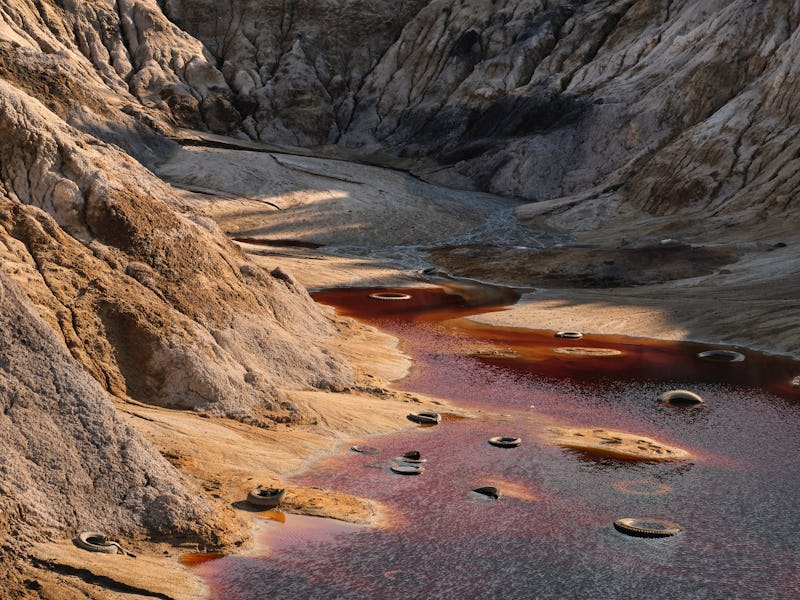Scientists think they've finally discovered what happened to Mars' water
Dust storms have been bleeding Mars dry for billions of years.

How did Mars lose its water? It’s one of the Solar System’s most enduring mysteries on one of its most intriguing planets.
Now, thanks to NASA’s Mars Atmosphere and Volatile Evolution (MAVEN) spacecraft, scientists have gained a richer understanding of the Martian atmosphere, getting to the core of how the planet functions — and they think they have an answer to the enigma.
To understand where the Martian water went, scientists looked up — a little over 92 miles, or 150 kilometers above the Martian surface, to be precise. What they found is detailed in a new study published Thursday in the journal Science.
Shane Stone is a planetary scientist at the University of Arizona and one of the authors on the new study. Looking at this specific part of the planet's atmosphere, rather than its surface, was critical to the scientists' newfound understanding of what happened to its water, he tells Inverse.
“This is the part of the atmosphere where we're transitioning from the atmosphere to space. It’s not a hard edge, but a smooth transition,” Stone says.
An artist's conception of MAVEN studying Mars.
All planets with an atmosphere, including Earth, have this transitory space. Earth’s is known as the exosphere. It’s where the light from stars breaks apart neutral molecules into their constituent parts, like carbon dioxide into carbon and oxygen.
And it is in this transitional space that Stone’s team found traces of water.
“It’s a real surprise and has significant implications for understanding the escape of water from the planet,” Stone says.
Dust devils — According to the new data, dust storms rising from the Martian surface appear to have been slowly sucking away the planet's water over the course of millions of years by sweeping water molecules up on a wild journey into the atmosphere. This happens on Earth, too — evaporated water molecules travel upwards until they condense from a gas back into a liquid, becoming rain-filled clouds. Where this process happens is known as the hygropause.
“On Mars, the hygropause is not operating as efficiently as it should be, not as efficiently as Earth’s hygropause,” Stone says. As a result, when water moves into Mars' upper atmosphere, it reacts with atmospheric molecules and is broken down into hydrogen and oxygen — the hydrogen can then escape the Martian atmosphere entirely, the study suggests — and is ultimately lost to space forever.
A 2001 dust storm engulfs the entirety of Mars.
The findings shed light on the Red Planet's evolution from a wet world, perhaps similar to Earth, to the desert-like world we know today. Scientists believe that while the Martian surface is riddled with ancient lake beds and rivers, the only water remaining may be trapped underground.
Martian weather — MAVEN can conduct research during Martian dust storms. While most other satellites take circular orbits, meaning they look at the same part of Mars at the same time of day, over and over again, MAVEN “samples different conditions on Mars continually, in terms of times of day, longitude and latitude," Stone says.
The Red Planet experiences regular regional dust storms, but in 2018 the planet was overtaken by a global dust storm. Stone describes the event as “very lucky” for the team, as it provided an unprecedented view of how the entire planet reacts to a storm.
A dust devil on Mars, captured by the ill-fated Opportunity rover in 2016.
Not everyone would refer to the 2018 storm as "lucky." While MAVEN was busy watching the skies, NASA’s Opportunity rover was patrolling the Martian surface. The dust storms settled on Opportunity’s solar panels, blocking out the sun’s rays and depriving it of energy — eventually putting an end to the rover’s historic journey.
“We were absolutely ecstatic when we got that dust storm...it giveth and it taketh away,” Stone says.
Abstract: Mars has lost most of its once-abundant water to space, leaving the planet cold and dry. In standard models, molecular hydrogen produced from water in the lower atmosphere diffuses into the upper atmosphere where it is dissociated, producing atomic hydrogen, which is lost. Using observations from the Neutral Gas and Ion Mass Spectrometer on the Mars Atmosphere and Volatile Evolution spacecraft, we demonstrate that water is instead transported directly to the upper atmosphere, then dissociated by ions to produce atomic hydrogen. The water abundance in the upper atmosphere varied seasonally, peaking in southern summer, and surged during dust storms, including the 2018global dust storm. We calculate that this transport of water dominates the present-day loss of atomic hydrogen to space and influenced the evolution of Mars’ climate.
Correction: A previous version of this article misstated the constituent parts of carbon dioxide. We regret the error.
This article was originally published on